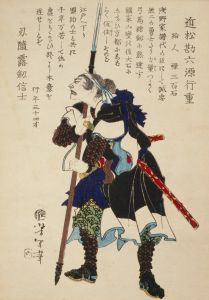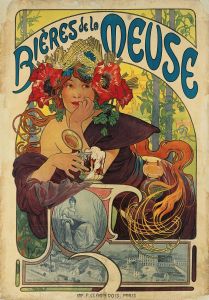
Ronin, or masterless Samurai, lunging forward
A hand-painted replica of Tsukioka Yoshitoshi’s masterpiece Ronin, or masterless Samurai, lunging forward, meticulously crafted by professional artists to capture the true essence of the original. Each piece is created with museum-quality canvas and rare mineral pigments, carefully painted by experienced artists with delicate brushstrokes and rich, layered colors to perfectly recreate the texture of the original artwork. Unlike machine-printed reproductions, this hand-painted version brings the painting to life, infused with the artist’s emotions and skill in every stroke. Whether for personal collection or home decoration, it instantly elevates the artistic atmosphere of any space.
"Ronin, or Masterless Samurai, Lunging Forward" is an artwork by Tsukioka Yoshitoshi, a prominent Japanese artist known for his contributions to the ukiyo-e genre during the late Edo and early Meiji periods. Yoshitoshi, born in 1839, is often celebrated for his innovative approach to traditional woodblock printing, which helped bridge the gap between classical and modern Japanese art.
Yoshitoshi's work is characterized by its dynamic compositions, vivid use of color, and a deep exploration of human emotions and historical themes. He was particularly interested in the lives of samurai, legendary figures, and the supernatural, often depicting scenes that captured the tension and drama of these subjects.
The artwork "Ronin, or Masterless Samurai, Lunging Forward" exemplifies Yoshitoshi's fascination with the samurai class, particularly the ronin, who were samurai without a lord or master. The image likely portrays a moment of intense action, capturing the ronin in mid-motion, possibly in a battle or a moment of personal resolve. This focus on movement and emotion is typical of Yoshitoshi's style, which often sought to convey the inner turmoil and external conflicts faced by his subjects.
Yoshitoshi's depiction of ronin reflects the broader cultural and historical context of Japan during his lifetime. The late Edo period was a time of significant social change, with the samurai class experiencing a decline in status and power. The Meiji Restoration, which began in 1868, further transformed Japanese society, leading to the modernization and Westernization of many aspects of life. In this context, the figure of the ronin became a symbol of both the romanticized past and the uncertain future, embodying themes of loyalty, honor, and existential struggle.
Yoshitoshi's work is also notable for its technical excellence. He was a master of the woodblock printing process, which involves carving images into wooden blocks, inking them, and pressing them onto paper. This technique allows for the creation of multiple copies of a single image, making ukiyo-e prints accessible to a wide audience. Yoshitoshi's prints are distinguished by their intricate details, careful composition, and the use of vibrant colors, which were achieved through the use of multiple blocks and layers of ink.
Throughout his career, Yoshitoshi produced a vast body of work, including series such as "One Hundred Aspects of the Moon" and "New Forms of Thirty-Six Ghosts," which further explore historical and supernatural themes. His influence on Japanese art is profound, and he is often credited with revitalizing the ukiyo-e tradition during a period of decline.
In summary, "Ronin, or Masterless Samurai, Lunging Forward" is a testament to Tsukioka Yoshitoshi's skill as an artist and his deep engagement with the cultural and historical narratives of his time. Through his work, Yoshitoshi not only preserved the legacy of the samurai but also contributed to the evolution of Japanese art, leaving a lasting impact that continues to be appreciated by audiences around the world.





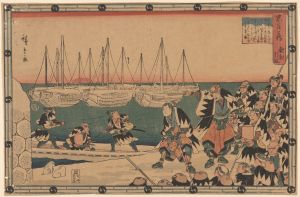
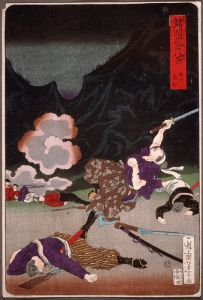
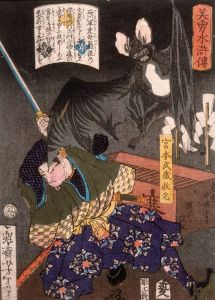
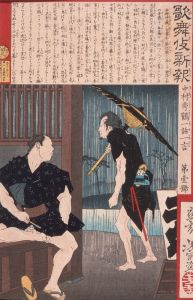

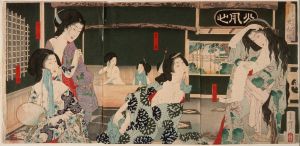


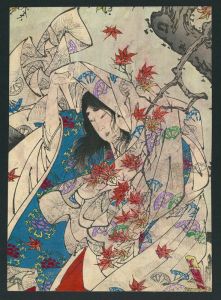
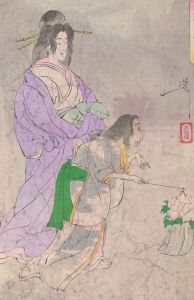
![Musha]taira no tomomori](/imgs/225657/s/tsukioka-yoshitoshi-mushataira-no-tomomori-bb591b96.jpg)
